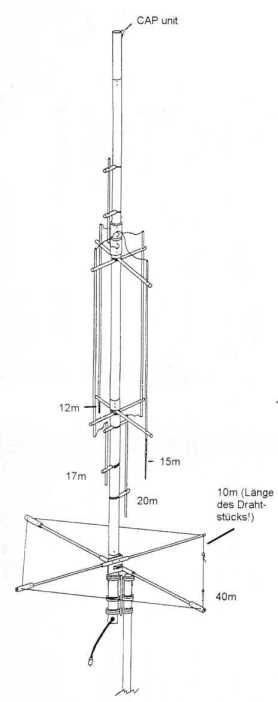Tests and operational report of a GAP Titan
Inhaltsverzeichnis
1 Legal
There are general regulations (federal state laws) saying that no building may be erected without permission if it is heigher than 10 meters or if ot encloses more than 10 cubic meters, both measured from ground up. These preconditions are all met with a standard mounting of a GAP TITAN. If you plan to mount it on a roof or on a mast, please contact your local construction authorities (Baubehörde).
This might be a reasonable step anyway, since there might be construction style regulations (Bebauungsplan). Such a set of local regulations might exist to preserve the general appearance of a historic neighbourhood and define limitations such as maximum construction heights. It will not be harmful anyway to send a letter to your local construction authorities and ask for permission. Simply attach the manufacturer's construction manual which you are going to download from the internet. And attach a map of your neighbourhood where you indicate the position where you plan to erect the antenna.
If you should receive a negative answer, the reply must indicate legal reasons for the denial and you still have the possibility to file an appeal (Einspruch einlegen). Most officials will be open to a discussion to help you out anyway.
I did so, and our mayor informed me that there were no indications whatsoever that would prohibit erecting such an antenna.
Please note that objections due to electromagnetic radiation are not related to the question whether you may erect an antenna or not. Figure out, you are just using it for receiving signals! Instead, such questions are related to operation, and that's a different field.
2 Mechanical
The TITAN is an overall 7.50 meters high, measured on overall length, from the base tube to the upper cap. The lower segment is a double-wall tube, making the aluminium a little more sturdy. I have fixed the guying ropes on the GAP isolator with the steel clamp that comes with the guying kit. Since this is a mechanically below the upper section, I have come to notice that the upper section waggles in the wind a little. But I don't deem it critical since the wind resistance is rather small anyway. On the long (years) run one might consider if the GAP will be worn out a little. Yet, if the TITAN serves me for 10 years, I will be content to buy some spare parts. anyway.
2.1 Counterpoise Sqare
The counterpoise square has a corner to corner diameter of little more than 4 meters. The aluminium rods have a really small diameter. Especially in central Europe, where we have experienced ice storms in the recent years, this kind of construction is very risky. Since the antenna has been devised in Florida, the manufacturers may not have thought of such a strain. It may stand a hurricane quite decently, but heavy icicles at the end will dead certain bend the tubes down, eventually cracking them off.
As a result, I would suggest to secure the rods to the main mast above, or simply unmount the counterpoise sqare during the winter.
2.2 Notes on Construction
Something important: If you start to mount all the components, you have the yellow coax cable coming out of the middle section. The manual says you should push it through the lower section and then fix the lower section with four screws to the middle section. But stop!!! You won't be able to lead the yellow cable through the bottom hole, if you mount the lower section right away. First take a small rasp and trim the edges of the hole so that they cannot damage the coax. Then lead the coax through the hole, and only after that, plug the lower tube into the middle section. The manufacturer's construction manual misses on that!
The rest is straightforward and can be done in one hour. It is very recommendable to mount the counterpoise right at the end when the antenna is readily mounted on the pole, since otherwise you might damage the counterpoise rods.
The antenna has an overall weight of 12 kilograms, so it can easily be set up by one single person. Nevertheless, it is a matter of safety to have a second person to screw the mounting brackets down to the pole.
As for the guying, consider the navigators' bowline knot (Palstek). It is extremely reliable and navigators have no reservations mooring their valuable ships with this kind of knot.
It also seems recommendable to attach some duct tape in order to keep the screews from dropping out. WAØSXV operates it in a rough environment in New Mexico and has reported of such occurrences after several years of operation.
2.3 Storm experience
- March 1st 2008, Storm EMMA: With wind speeds in gusts of 70 kts my TITAN has suffered no damages at all.
3 Electrical
Here's an excellent description of how the TITAN works:
http://www.njqrp.org/data/gap.html
4 Propagational
Here's an excellent description on the TITAN's propagation features:
http://www.qsl.net/aa3rl/titandtl.html
5 Operational
Well, the problem here is to find a method which can yield reliable results. There are many factors which can influence test results. I want top point out that any change in these conditions may produce different results. If you plan to set up a TITAN at your site, you may report different experiences!
- surrounding metal devices such as water drainages or aluminium veggie houses or garden fences
- conductivity of the soil
- nearby buildings casting radio shadows
- solar flux and general DX conditions
Under conditions such as portrayed in pictures on my GAP TITAN page I must say that it is an excellent compromise between space consumption and band coverage. It has resonnances on eight HF bands, complies with German construction law, does not require any permissions, does not heat the soil but efficiently radiates a major part of the fed electrical power and has a limited optical footprint. Convincing enough?
